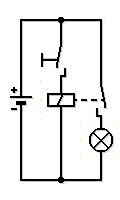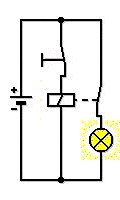
|
Computer - simply explained 1
My personal introduction to computers, goes back to the simplest experiences with electro-technology. This was the switching circuit of a consumer through a power relay, in this case it was just a lamp. At the time
however, I was asking myself the question: why do I need a relay when I can also switch the lamp on directly?
 
For the sake of accuracy, the complete closed power-circuit has been added. One can read more about the power relay here. If however, instead of a
manual switch, you can
imagine one operated by a hot-wire, with a bit of skill, the result could be a flashing light whose frequency can be regulated by cleverly inserting various resistances.
Now, what has this got to do with the computer? This is the first time that something happens automatically. All you have to do is switch it on, after that the process runs by itself. By the way, the reversal of the switching
function through a power relay, appeared to make more sense to me.
One moves the switch to the 'on' position and the light goes off. Like it is in the simple motor car interior light. You close the door, this operates a contact switch and the light goes out. Granted, in this case a power relay
is not even necessary. Another example would be the typical stairwell-lighting in a block of flats. A quick press of the button and the light goes on and stays on for a certain length of time.
Indeed, the road to computers is still long. However, modern indicators are already equipped with controllers. For the moment, we'll disregard those controlled through the CAN-Bus. When pressed, they flash three
times, if one maintains the contact and after two flashes the contact is broken, the indicator stops flashing.
In the meantime, we have to accept the fact that in today's cars there are an unbelievable amount of mini-computers. However, let's go back to our slow understanding. There really were enormous banks of power
relays, e.g., in the systems made by Konrad Zuse in the 1940s. He is considered to be the father of the modern computer, even though these were based exclusively on the transistor technology.
The invention of the transistor and it's complete development into an industrially usable component only took place later. Nonetheless, Zuse's computer could indeed, handle simple arithmetic operations. Of course,
these operation are only possible if the computer can be fed with numbers. This process is thus called 'program-controlled'.
In addition of course, Zuse couldn't use a keyboard yet (there was no such thing). For one of these, the whole mechanism, which was the size of a wall-to-wall cupboard, wouldn't have been sufficient. Since after all, the
machine would have to repeatedly be told whether a key had been pressed and if so, which one was it. Sometimes one notices that even today's computers are so overworked, that they no longer react the keyboard
input.
Zuse had to manage with holes, which were in fact, punched into an approx. 35 mm wide strip of film. By the way, even up to about 30 years later one was still using punch-cards to give the computers their commands.
Their holes (or the lack thereof) could be queried by the computer, which could then carry out its task. You may understand now, why today, the great distinction between input, processing and output is made.
In the case of a Tablet, this distinction is of course, hardly possible. The breakdown of these commands is also important, because although the enormous speed of today's computers began with the transistor, so did
the low-current technology. If the relays, with their contacts, were to directly take over controlling tasks, the calculation output would have to be considerably strengthened.
Now you also know one of the reasons why the cooling is necessary. However, let's continue. Even though the punch card does represent a type of storage, it cannot be used by the computer, e.g., to store and put aside
certain values which are to be used at a later stage. Thus the race for storage space was started, at first, only the working memory (RAM) was considered.
|
|